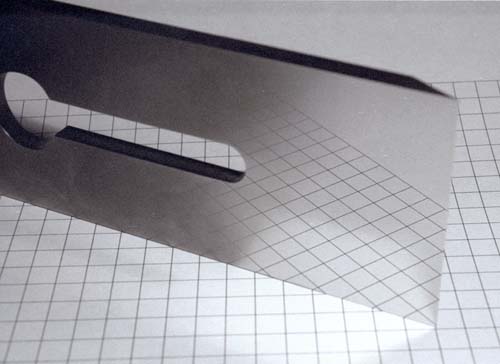The interaction of the different alloys of steel with the various sharpening abrasives I’ve tested is more complicated than I had expected.
My evaluation of each abrasive is based on the appearance of the surface it produces as seen under the microscope, and the sharpness of the resulting cutting edge, as measured by the thread cutting test. Of these two, the performance of the blade in planing tests corresponds very closely to the thread test, but not to the appearance of the edge under the microscope.
It turns out that the intersection of two finely honed surfaces that appear under the microscope to be scratch-free does not guarantee a truly sharp edge. Specifically, I’ve found that the more highly carbided alloys will not achieve their sharpest edges when honed on even the finest waterstones. Very careful technique will produce a uniform surface and eliminate all traces of a wire edge, but when tested either by planing or by cutting thread, the edge is less sharp than one produced by honing with diamond. More commonly used alloys (high carbon and A2) will reach a truly sharp edge when honed on waterstones.
After realizing this, I’ve begun sharpening each of my test blades using different honing abrasives to see which will produce the best edge on that particular type of steel. [This testing is still being done.] My results so far are that ½ micron diamond paste will produce a very sharp edge on all of the blades fairly quickly, and 0.5 micron CrO microabrasive paper will produce a slightly better edge much more slowly.
Shiny Surfaces and Matte Surfaces
Some waterstones produce surfaces that appear flat and gray rather than shiny. This is true of the King 800x and the Takenoko 8000x stones, although the latter gives a gray surface that reflects a faint mirror-like image. The Takenoko nevertheless produces quite a sharp edge. I’ve found that a bright-looking surface produced by a Shapton 2000x ceramic stone will become less reflective when honed on the Takenoko stone, while at the same time the cutting edge becomes sharper. This suggests that judging the surface quality of a blade by its bright appearance can be misleading. Surface quality seems more closely correlated to the ability to see a mirror-like reflected image than to the brightness of the surface.
The most highly reflective, mirror-like surfaces I’ve achieved were done with fine diamond paste using hard maple as a substrate. I believe the diamond particles embed in the maple, causing them to produce shallower scratches than they make when used on a cast iron plate. Here’s a picture of a CPM 3V blade after its back was honed with 1 micron diamond paste on maple:

Under the microscope, the surfaces of this blade still showed larger scratches, probably caused by diamond particles larger than 1 micron that are present in the paste.
Other lapping pastes can produce mirror-like surfaces quite quickly, but under magnification the surfaces show many deeper scratches. This is especially true of the Tormek lapping compound, which may be responsible for the accounts I’ve read of the poorer edge retention of blades honed using the Tormek system.
Despite the high quality of surface produced by diamond on maple, I’ve gone back to using diamond on cast iron as my preferred method. When I used the maple substrate, I found that the edges of the blade were becoming dubbed (slightly rounded) more and more as I did repeated lapping. After all the trouble I had taken to achieve a very flat surface, I wasn’t willing to sacrifice it. The maple substrate also required considerable maintenance, as it either wore away or changed shape due to changes in moisture content. Diamond on maple is probably most appropriate for honing carving tools that don’t need flat surfaces, or for the quick final honing of a sharp edge produced by other methods.